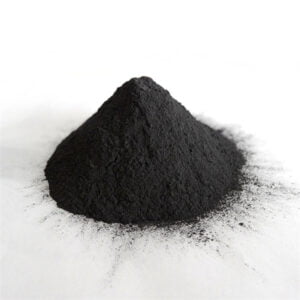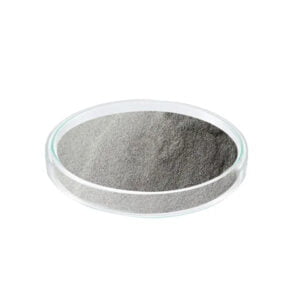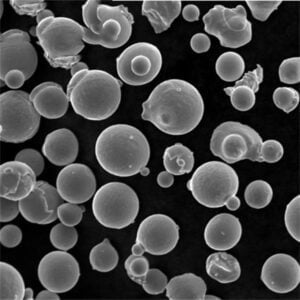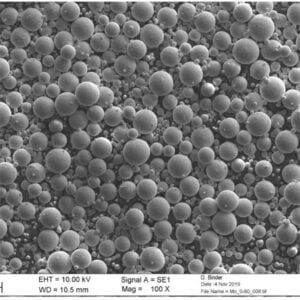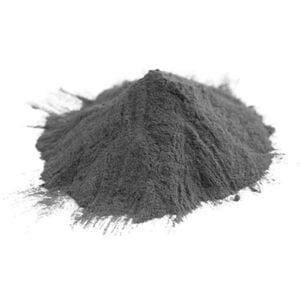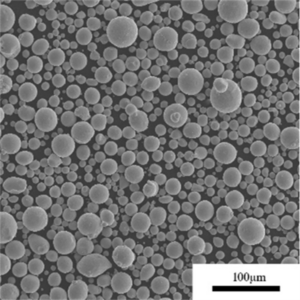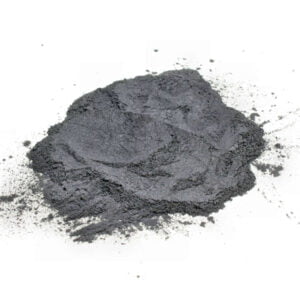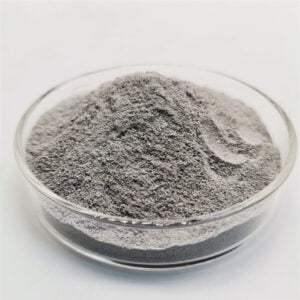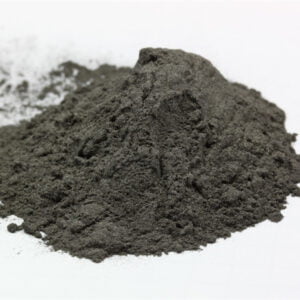Prášky z molybdenu a titanu
Obsah
Přehled molybdenových titanových prášků
molybden titanové prášky označují jemné kovové částice každého prvku produkované atomizačními procesy. Vyznačují se vysokou pevností, tvrdostí a tepelnou odolností.
Prášky se používají jednotlivě nebo jako směsi pro výrobu vysoce výkonných slitin. Jejich řízená distribuce velikosti částic umožňuje sestavení složitých součástí téměř čistého tvaru z vrstev během kovového 3D tisku.
Některé klíčové vlastnosti molybdenových a titanových prášků:
Prášek molybdenu
- Vynikající odolnost proti tečení a stabilita při vysokých teplotách
- Nízký koeficient tepelné roztažnosti
- Vysoká tvrdost a odolnost proti opotřebení
- Používá se jako legovací přísada pro zpevnění ocelí a superslitin
Titanový prášek
- Extrémně pevný a přitom lehký jako konstrukční kov
- Vynikající odolnost proti korozi
- Biokompatibilní pro lékařské implantáty
- Reaktivní a vyžaduje řízené zpracování
Smíšené/legované prášky
- Kombinujte prospěšné vlastnosti každého prvku
- Umožňuje přizpůsobený materiálový výkon
- Vyžaduje optimalizované parametry 3D tisku
Manipulací se složením prostřednictvím AM lze vytvořit inovativní slitiny s vynikajícími vlastnostmi vhodnými pro extrémní prostředí.
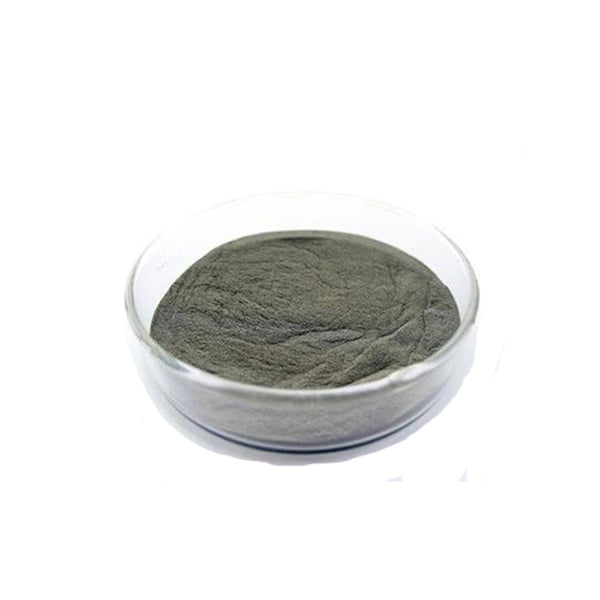
Druhy molybdenových a titanových prášků
Molybdenové a titanové prášky jsou komerčně dostupné v různých typech pro výrobu kovových přísad:
| Prášková varianta | Charakteristika | Typická použití |
|---|---|---|
| Molybden | Čisté a legované druhy | AM moly slitin, katalyzátory |
| Titan Ti-6Al-4V | Letecká slitina | Nosné konstrukce |
| Titan Ti-6Al-7Nb | Biokompatibilní alfa-beta slitina | Lékařské implantáty, protetika |
| Mo-Ti elementární směsi | Vlastní složení slitin | Pokročilé technické aplikace |
| Předslitiny Mo-Ti | Předlegované směsi | Zjednodušené AM zpracování |
Ve své elementární formě poskytuje molybden tvrdost při vysokých teplotách, zatímco titan přispívá k pevnosti a odolnosti proti korozi. Kombinací obou prostřednictvím AM lze vytvářet inovativní slitiny se zvýšeným celkovým výkonem.
Složení/legování
Molybdenové a titanové prášky mají následující nominální složení:
Prášek molybdenu
| Živel | Rozsah složení |
|---|---|
| molybden (Mo) | 99% a vyšší |
| Kyslík (O) | 0,01% max |
| uhlík (C) | 0,01% max |
| železo (Fe) | 0,01% max |
| Ostatní kovy | 0,01% max |
Vysoká čistota je vyžadována pro reprodukovatelnost během AM a následného zpracování. Znečištění může nepříznivě ovlivnit vlastnosti materiálu.
Titan Ti-6Al-4V
| Živel | Hmotnost % |
|---|---|
| titan (Ti) | Zůstatek |
| hliník (Al) | 5.5-6.75 |
| Vanad (V) | 3.5-4.5 |
| železo (Fe) | < 0,3 |
| Kyslík (O) | <0.2 |
| Ostatní kovy | <0.1 |
Malá množství legujících přísad hliníku a vanadu významně zvyšují pevnost titanu pro nosné lehké konstrukce.
Pro smíšené prášky Mo-Ti lze relativní poměry měnit od 100% Mo do 100% Ti pro vytvoření přizpůsobených slitin. Použití jak elementárních, tak předem legovaných směsných prášků umožňuje neomezená svoboda složení, aby byly prostřednictvím AM vyvinuty dosud neprozkoumané slitiny.
Vlastnosti molybden titanové prášky
Prášek molybdenu
| Fyzikální vlastnosti | |
|---|---|
| Hustota | 10,22 g/cm3 |
| Bod tání | 2610 °C |
| Tepelná vodivost | 138 W/mK |
| Elektrický odpor | 5,5 μΩ-cm |
| Koeficient tepelné roztažnosti | 5,3 μm/m-°C |
| Mechanické vlastnosti | |
|---|---|
| Tvrdost | ~300 HV |
| Maximální pevnost v tahu | 600-800 MPa |
| Mez kluzu (posun 0,2%) | 500+ MPa |
| Prodloužení | 30-50% |
| Modul pružnosti | 325 GPa |
Molybdenový prášek umožňuje výrobu extrémně tvrdých a tepelně odolných slitin pomocí AM technik. Díly si zachovávají vysokou pevnost v oxidačních, korozních a třecích podmínkách opotřebení při zvýšených teplotách přesahujících 1000 °C.
Prášek titanu Ti-6Al-4V
| Fyzikální vlastnosti | Hodnoty |
|---|---|
| Hustota | 4,43 g/cm3 |
| Bod tání | 1604-1660°C |
| Tepelná vodivost | 7,2 W/mK |
| Elektrický odpor | 170 μΩ-cm |
| Coeff. tepelné expanze | 8,6 μm/m-°C |
| Mechanické vlastnosti | Jak Postaveno | Žíhané |
|---|---|---|
| Pevnost v tahu | 1050 MPa | 950 MPa |
| Mez kluzu (posun 0,2%) | 900 MPa | 850 MPa |
| Prodloužení | ~15% | ~20% |
| Tvrdost | ~350 HV | ~300 HV |
Jemné vyvážení vysoké pevnosti spolu s slušnou tažností z ní činí extrémně oblíbenou slitinu pro letectví a kosmonautiku pro kritické tištěné díly v raketových motorech, drakech letadel a turbínách.
Smícháním molybdenových a titanových prášků v různých poměrech lze dosáhnout kombinace jejich vlastností v přizpůsobených slitinách.
Aplikace molybdenových titanových prášků
| Oblast použití | Vlastnosti s pákovým efektem | Příklady |
|---|---|---|
| Letectví a obrana | Vysoký poměr pevnosti k hmotnosti, vynikající tepelná odolnost | – součásti leteckých motorů (disky, lopatky) <br> – Pouzdra střel – Tepelné štíty |
| Biomedicína | Biokompatibilní, dobrá odolnost proti korozi, vysoká pevnost | – Ortopedické implantáty (náhrady kyčelních kloubů, kolenních kloubů) - Zubní implantáty – Chirurgické nástroje |
| Chemické zpracování | Odolnost proti korozi, dobrá obrobitelnost | – Chemické reaktory a nádoby – výměníky tepla – Hřídele míchadel |
| Elektronika a elektrotechnika | Vysoká elektrická vodivost, dobrá tepelná stabilita | – Elektrické kontakty a konektory – Vysoce výkonné rezistory – Elektrody pro elektroerozivní obrábění (EDM) |
| Aditivní výroba | Vlastnosti přizpůsobitelné, možné složité geometrie | – Lehké, vysoce výkonné komponenty pro letecký a automobilový průmysl – Biokompatibilní implantáty s přizpůsobenými strukturami – Komplexní výměníky tepla pro efektivní tepelné řízení |
Specifikace molybdenových titanových prášků
Molybdenové a titanové prášky musí splňovat přesné chemické požadavky a přísné kvalitativní specifikace pro použití při výrobě aditiv podle průmyslových standardů:
Standardy chemické čistoty
| Stupeň prášku | Standard |
|---|---|
| Molybden | ASTM B393 |
| Titan Ti-6Al-4V | ASTM F2924 |
| Titan Ti-6Al-7Nb | ASTM F3001 |
Typické vlastnosti prášku
| Atribut | Požadavky | Zkušební metody |
|---|---|---|
| Tvar částic | Převážně sférické | SEM zobrazování podle ASTM B822 |
| Zdánlivá hustota | 2 až 5 g/cc | MPIF 04 nebo ASTM B212 |
| Průtoková rychlost | >30 sekund pro Hallův test průtoku | ASTM B213 |
| Distribuce velikosti částic | D10, D50, D90 optimalizované pro AM proces | ASTM B822 |
| Ztráta při zapalování (LOI) | Nízký obsah kyslíku/dusíku | Analýza fúze inertních plynů |
| Mikrostruktura | Bez závad, bez satelitů | SEM při velkém zvětšení |
Cílem požadavků je zajistit rovnoměrné chování při tavení, bezvadné vytváření a reprodukovatelné vlastnosti koncových dílů.
Globální dodavatelé
Mnoho zavedených výrobců poskytuje molybdenové a titanové prášky pro AM aplikace:
Prášek molybdenu
| Společnost | Názvy značek | Způsob výroby |
|---|---|---|
| HC Starck | Mo | Elektrolytické |
| Molymet | PureMo | Redukce vodíku |
| Plansee | MolyPowder | Redukce vápníku |
| Midwest Tungsten | TeroMoly | Redukce vápníku |
Titanový prášek
| Společnost | Nabízené třídy | Výrobní metody |
|---|---|---|
| AP&C | Ti-6Al-4V, ostatní slitiny Ti | Plazmová atomizace |
| Přísada pro tesaře | Ti-6Al-4V | Plazmová atomizace |
| Sandvik | Ti6Al4V ELI, Ti6Al4V ELI-0406 | Plazmová atomizace |
| Tekna | Ti-6Al-4V, Ti 6Al-7Nb | Plazmová atomizace |
| Technika TLS | Ti6Al4V, Ti6Al4V ELI, Ti Grade 23 | Plyn, plazmová atomizace |
Jak zavedení výrobci kovových prášků, tak i specializovaní výrobci AM prášku poskytují tyto materiály podle náročných průmyslových specifikací.
Stanovení cen molybden titanové prášky
Jako široce používané materiály v metal AM jsou k dispozici publikované cenové ukazatele pro molybdenové a titanové prášky:
Prášek molybdenu
| Velikost částic | Cenové rozpětí |
|---|---|
| 10-45 μm | $40 – $60 na kg |
| 15-53 μm | $50 - $70 na kg |
| Vlastní velikosti | > $100 na kg |
Prášek titanu Ti-6Al-4V
| Velikost částic | Cenové rozpětí |
|---|---|
| 15-45 μm | $150 – $450 na kg |
| 45-100 μm | $100 – $350 na kg |
| Vlastní velikosti | > $500 na kg |
Ceny závisí na kvalitě, velikosti šarže, distribučním rozsahu, atomizaci plazmou vs. plynem a objemu nákupu. Velké množství a smluvní ceny se obvykle sjednávají přímo s dodavateli.
Klady a zápory molybdenu a slitin titanu od AM
| Vlastnosti | Slitiny molybdenu (AM) | Slitiny titanu (AM) |
|---|---|---|
| Síla | Velmi vysoká pevnost a odolnost proti tečení při zvýšených teplotách. Ideální pro vysoce výkonné aplikace v leteckém a energetickém sektoru. | Vynikající poměr pevnosti a hmotnosti. Lehčí než ocel, ale nabízí srovnatelnou pevnost, díky čemuž jsou cenné v letectví, automobilovém průmyslu a biomedicíně. |
| Hmotnost | Relativně hustá ve srovnání s titanem, ale stále lehčí než mnoho jiných vysoce výkonných kovů. | Výrazně lehčí než ocel, nabízí podstatné výhody snížení hmotnosti v aplikacích, kde je hmotnost kritická. |
| Odolnost proti korozi | Obecně dobrá odolnost proti korozi, zejména v redukčních prostředích. Při vysokých teplotách však může být náchylný k oxidaci. | Vynikající odolnost proti korozi v různých prostředích, včetně mořské vody a tekutin lidského těla. Výhodný materiál pro námořní aplikace a biomedicínské implantáty. |
| Biokompatibilita | Omezená biokompatibilita kvůli potenciálnímu uvolňování molybdenových iontů v těle. Není ideální pro většinu lékařských implantátů. | Vynikající biokompatibilita, díky čemuž jsou vhodné pro implantáty a protetiku. |
| Výkon při vysokých teplotách | Udržuje pevnost a odolnost proti tečení při vysokých teplotách, což umožňuje použití v horkých sekcích proudových motorů a dalších extrémních prostředích. | Může si zachovat dobré mechanické vlastnosti při zvýšených teplotách, ale ne v takovém rozsahu jako slitiny molybdenu. |
| Tepelná vodivost | Velmi dobrá tepelná vodivost, umožňující efektivní odvod tepla ve vysokoteplotních aplikacích. | Mírná tepelná vodivost, nižší než u molybdenu, ale dostatečná pro mnoho aplikací. |
| Možnost tisku aditivní výroby (AM). | Prášek molybdenu může být náročný na zpracování kvůli jeho vysokému bodu tání a reaktivitě. Vyžaduje specializované AM techniky, jako je tavení elektronovým paprskem (EBM). | Snadněji tisknutelné pomocí různých AM technik, jako je selektivní laserové tavení (SLM) a tavení elektronovým paprskem (EBM). Vlastnosti prášku a potiskovatelnost se mohou lišit v závislosti na konkrétní titanové slitině. |
| Náklady | Molybden je relativně hojný prvek, ale proces AM může být drahý kvůli speciálnímu vybavení a požadavkům na manipulaci. | Titan je sám o sobě dražší prvek než molybden. Pokrok v technologii AM však snižuje cenu titanových dílů. |
| Povrchová úprava | Molybdenové díly vyrobené AM mohou mít drsnou povrchovou úpravu, což vyžaduje dodatečné kroky následného zpracování. | Titanové díly AM mohou dosáhnout dobré povrchové úpravy v závislosti na konkrétním procesu AM a použitých parametrech. |
| Aplikace | – Vysokoteplotní komponenty v proudových motorech a raketových motorech – Výměníky tepla – Molybdenové kelímky pro vysokoteplotní tavicí procesy | – Letecké součásti (části letadel, podvozky) – Biomedicínské implantáty (náhrady kolen, kyčelní klouby) – Automobilové díly (ojnice, komponenty zavěšení) – Sportovní zboží (golfové hole, rámy jízdních kol) |
Jak se vyrábí molybdenový a titanový prášek?
Pokročilé procesy plynové atomizace vyrábějí jemné kovové prášky s přesnou kontrolou kritických charakteristik, jako je tvar částic, rozsah velikostí a chemická čistota.
Atomizace plynu
Ingoty vysoké čistoty se indukčně taví v inertní atmosféře a proud tekutého kovu se nalévá do specializovaných atomizačních nádob. Výkonné trysky argonu nebo dusíku rozprašují kov na jemné kapičky, které rychle tuhnou na prášek.
Optimalizací parametrů průtoku plynu a rychlostí chlazení se získají kulovité částice s požadovanou distribucí velikosti částic. Prášek se pak prosévá do různých velikostních tříd požadovaných pro různé AM procesy.
Další zpracování
Pro zlepšení vlastností prášku mohou být podniknuty další kroky – odplynění na nižší obsah kyslíku, žíhání pro snížení vnitřního pnutí z rychlého tuhnutí a smíchání s jinými frakcemi prášku pro získání specifických velikostí.
Prášky jsou nakonec baleny v inertní atmosféře, aby se zabránilo oxidaci před odesláním zákazníkům. Manipulační a skladovací protokoly zabraňují absorpci vlhkosti nebo kontaminaci během následného zpracování kovů AM.
Binder Jetting versus Powder Bed Fusion molybdenu a titanu
Slitiny molybdenu a titanu lze tisknout jak pomocí tryskování pojiva, tak fúzí práškového lože:
| Aspekt | Tryskání pojiva | Powder Bed Fusion |
|---|---|---|
| Metoda sestavení | Kapalná pojiva | Tavení laserem/e-paprskem |
| Rozlišení | ~100 μm | ~50 μm |
| Pórovitost | Vyšší, vyžaduje infiltraci | Nižší, hustota 99%+ |
| Povrchová úprava | Hrubý, potřebuje opracování | Střední, může vyžadovat dokončení |
| Mechanické vlastnosti | Nízká, mění se v jednotlivých částech | Vyšší, jednotnější |
| Rozměrová přesnost | ±0,3% se smrštěním | ±0,1% nebo lepší |
| Následné zpracování | Odstraňování pojiva, slinování, HIP | Odstraňování podpory, tepelné zpracování |
| Velikost sestavení | Průmyslové měřítko | Menší komory |
| Časové požadavky | Dny | Hodiny až 1-2 dny |
| Ekonomika | Nižší cena dílů, vyšší objem | Nižší hlasitost, drahý hardware |
Binder jetting je vhodný pro designové koncepční modely díky rychlosti a nízké ceně. Fúze v práškovém loži vytváří vysoce věrné díly pro konečné použití s vynikajícími vlastnostmi.
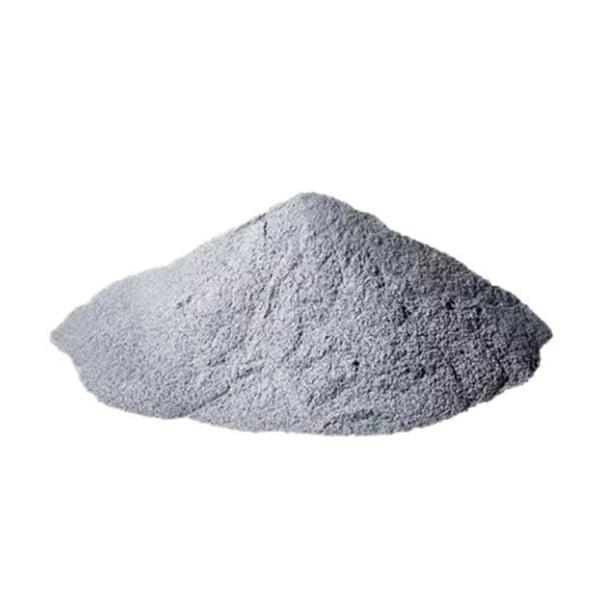
Molybden titanové slitiny – vyhlídky
| Vlastnosti | Popis | Výhody | Potenciální výzvy |
|---|---|---|---|
| Vynikající mechanické vlastnosti | Molybden (Mo) zpevňuje titan (Ti) a vytváří slitiny s výjimečným poměrem pevnosti k hmotnosti, vysokou odolností proti tečení (odolnost proti deformaci při namáhání při vysokých teplotách) a dobrou únavovou pevností (odolnost proti porušení při cyklickém namáhání). | – Ideální pro aplikace vyžadující lehké a přitom robustní komponenty, zejména při zvýšených teplotách. – Umožňuje efektivní návrhy díky menšímu množství materiálu potřebného pro stejnou úroveň pevnosti ve srovnání s těžšími alternativami. | – Přídavek molybdenu může snížit tažnost slitiny (schopnost plasticky se deformovat), což potenciálně omezuje její tvarovatelnost pro složité tvary. – Zpracování těchto slitin může být složité a vyžaduje specializované techniky, což může mít dopad na nákladovou efektivitu. |
| Vylepšený výkon při vysoké teplotě | Vysoký bod tání molybdenu zvyšuje maximální provozní teplotu slitin Ti-Mo ve srovnání s nelegovaným titanem. | – Umožňuje jejich použití v prostředí s extrémním teplem, jako jsou tryskové motory, součásti raket a vysoce výkonné pece. – Poskytuje prodlouženou životnost součástí v náročných tepelných aplikacích. | – Oxidační odolnost, schopnost odolávat reakci s kyslíkem při vysokých teplotách, může být problémem u některých slitin Ti-Mo. Pokračuje výzkum zaměřený na zlepšení jejich oxidačního chování pomocí legovacích přísad nebo povrchových úprav. |
| Aplikace elektrické vodivosti | Některé slitiny Ti-Mo, zejména ty s vyšším obsahem Mo, vykazují dobrou elektrickou vodivost. | – Užitečné pro aplikace vyžadující přenos elektrického proudu, jako jsou elektrody, elektrické kontakty a vysoce výkonné rezistory. – Nabízí potenciální materiálovou alternativu k tradičním vodičům, jako je měď, ve specifických scénářích. | – Elektrická vodivost slitin Ti-Mo se nemusí vždy shodovat s vodivostí čisté mědi, což vyžaduje pečlivý výběr materiálu na základě potřeb konkrétní aplikace. – Křehké chování při nízkých teplotách může omezit jejich použití v kryogenních aplikacích. |
| Vznikající potenciál aditivní výroby | Vývoj práškových slitin Ti-Mo kompatibilních s aditivními výrobními technikami, jako je 3D tisk, otevírá nové možnosti pro komplexní design komponent a lehké konstrukce. | – Umožňuje vytváření složitých geometrií a příhradových struktur, což může vést ke snížení hmotnosti a lepšímu výkonu. – Nabízí větší svobodu designu ve srovnání s tradičními výrobními metodami. | – Výroba prášku a optimalizace potiskovatelnosti pro slitiny Ti-Mo jsou oblastmi probíhajícího výzkumu. – Zajištění konzistentních vlastností materiálu a kontroly kvality v celém procesu aditivní výroby vyžaduje další vývoj. |
| Růst a rozvoj trhu | Očekává se, že celosvětový trh se slitinami Ti-Mo zažije stálý růst v důsledku rostoucí poptávky v leteckém, biomedicínském a energetickém sektoru. | – Rostoucí poptávka po lehkých a vysoce výkonných materiálech v těchto odvětvích pohání expanzi trhu. – Technologický pokrok v metodách zpracování a výroby může dále zlepšit efektivitu nákladů a rozšířit aplikační potenciál. | – Konkurence zavedených materiálů, jako je hliník a vysoce výkonné oceli, může omezit podíl na trhu v určitých odvětvích. – Kolísání cen molybdenu a titanu může ovlivnit celkovou cenu slitin Ti-Mo. |
Nejčastější dotazy
Otázka: K čemu se molybden používá?
Odpověď: Díky vynikajícím vlastnostem při vysokých teplotách vidí molybden hlavní použití jako legovací přísada pro zpevnění žáruvzdorných ocelí a superslitin používaných v letectví, výrobě energie, konstrukci pecí, součástí raket a dalších náročných aplikacích.
Otázka: Je molybden toxický?
Odpověď: Elementární molybden a jeho slitiny mají obecně nízkou úroveň toxicity a jsou bezpečné pro technické použití. Některé sloučeniny molybdenu však při dlouhodobém vdechování mohou mít potenciální karcinogenní účinky, které vyžadují použití ochranných prostředků během manipulace a obrábění.
Otázka: Je titan drahý?
Odpověď: Slitiny titanu vykazují vyšší náklady na suroviny ve srovnání s ocelí a slitinami hliníku. Nicméně, s poměry buy-to-fly blížící se 1 pro AM výrobu, mohou být náklady na hotové titanové díly ekonomické pro průmyslová odvětví, jako je letecký průmysl, kteří chtějí přijmout nové technologie a návrhy.
Otázka: Proč je titan ideální pro implantáty?
Odpověď: Biokompatibilita titanových slitin ve spojení s jejich vysokým poměrem pevnosti k hmotnosti je činí ideálními pro náhradu lidské kosti. Modul pružnosti lze snížit blíže k modulu pružnosti kosti legováním s biokompatibilními beta stabilizátory, jako je Nb a Ta, pro zlepšení životnosti nosných implantátů.
Otázka: Jaký proces 3D tisku se používá pro molybden a titan?
Odpověď: U vysoce výkonných dílů pro konečné použití se převážně používají techniky fúze práškového lože, jako je selektivní laserové tavení (SLM) a tavení elektronovým paprskem (EBM). Vysokoteplotní zdroj tepla dosahuje téměř plné hustoty budov s vynikajícími vlastnostmi vhodnými pro technické aplikace.
Otázka: Proč míchat molybden s titanovým práškem?
Odpověď: Molybden zvyšuje tvrdost při vysokých teplotách, odolnost proti tečení a vlastnosti podobné nástrojové oceli, zatímco titan přispívá k vynikající odolnosti proti korozi a nízké hustotě. Společně přizpůsobené slitiny vyrobené přímým smícháním jejich prášků pomocí AM poskytují ideální kombinaci pro pokročilé aplikace.
Sdílet na
MET3DP Technology Co., LTD je předním poskytovatelem řešení aditivní výroby se sídlem v Qingdao v Číně. Naše společnost se specializuje na zařízení pro 3D tisk a vysoce výkonné kovové prášky pro průmyslové aplikace.
Dotaz k získání nejlepší ceny a přizpůsobeného řešení pro vaše podnikání!
Související články

Vysoce výkonné segmenty lopatek trysek: Revoluce v účinnosti turbín díky 3D tisku z kovu
Přečtěte si více "O Met3DP
Nedávná aktualizace
Náš produkt
KONTAKTUJTE NÁS
Nějaké otázky? Pošlete nám zprávu hned teď! Po obdržení vaší zprávy obsloužíme vaši žádost s celým týmem.

Kovové prášky pro 3D tisk a aditivní výrobu
SPOLEČNOST
PRODUKT
kontaktní informace
- Město Qingdao, Shandong, Čína
- [email protected]
- [email protected]
- +86 19116340731






